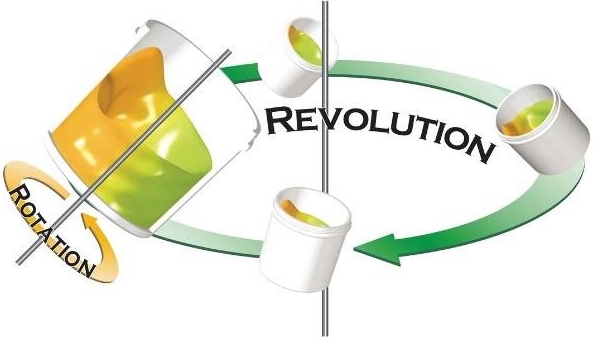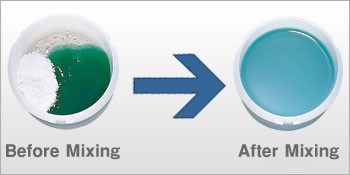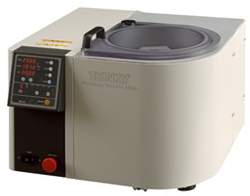The first six posts in this series covered the various types of equipment used to disperse fillers into uncured thermoset resins. The information was applicable to all sizes of mixing equipment. This post will focus on laboratory size mixers for use during formulation development and testing. In the formulation phase, multiple iterations are typically required to optimize the filler loading, the curing package, the rheological properties and the fully cured mechanical properties. The availability of small-scale mixing equipment is crucial. Fortunately, there are many types of laboratory size mixers and dispersers.
Most popular lab mixing method is dual axis centrifugal mixers from suppliers such as:
- SpeedmixerTM
- Thinky
- Torrey Hills
- Others
The operational concept of the dual axis centrifugal mixer is shown in Figure 1.
Figure 1. Working principle for a planetary centrifugal mixer (source: Thinky)
The mixing action is the result of the dual axis of rotation. The materials to be mixed are added to the disposable cup, the cup is rotated around the cup axis while the high-speed mixing arm revolves in a circular motion in the opposite direction. The resulting motion has been termed dual asymmetric centrifuge (SpeedMixerTM) or generically dual axis centrifugal mixer (DAC). The dual axis centrifugal motion causes significant material movement and efficient high-shear mixing resulting in short mixing times (5 seconds to approximately 5 minutes).
Figure 2. Mixing example where a single powder is mixed in a liquid
Figure 2 depicts a simple mixing of a two-component system with a single powder and a viscous liquid. In this case, the components were loaded side-by-side. In my experience, this is not typical, but makes for a nice demonstration. The advantage of DAC lab mixers is that the ingredients may be weighed directly into a disposable mixing cup. For example, if your formulation has several resin components, liquid additives, diluents, adhesion promoters, etc. these can be sequentially added (tare-weigh-tare-weigh until all ingredients are added). Since the centrifugal mixing pulls material into the liquid, in most cases the liquid components are typically added first and the powders added on the top. As discussed in previous posts, it is prudent to conduct careful order of addition experiments during the initial formulation trials.
Commercial lab-scale mixers have the capability to set-up mixing programs to ensure consistent mixing from one lab batch to another.
SpeedMixerTM (Model DAC 150.1 FVZ-K without vacuum)
An added feature of some of the lab-scale centrifugal mixers is the ability to vacuum degas during mixing. There is an argument that vacuum is not necessary due to the dispersing action of the dual axis centrifugal forces (pushes air out during mixing). Filler incorporation inherently pulls very fine air pockets into the resin during the initial mixing and in order to get good dispersion and remove air, some applications require vacuum degassing.
Thinky mixer (model ARV-310 with vacuum)
The advantages of dual axis centrifugal mixers are:
- Reproducible mixing – Perfect mixing every time thanks to precision centrifugal mixing in a precision machine.
- Reduced bubble entrapment resulting from mixing and deaeration achieved simultaneously thanks to DAC (dual asymmetric centrifugal) technology.
- Easy cleanup since centrifugal mixing is performed in inexpensive and disposable containers.
- Mix a wide variety of materials – High sheer mixing, high viscosity mixing, semi-solids, pastes, oils, liquids, powders, creams, in any combination, within a few seconds to a few minutes.
- Simple clean-up since there are no blades or bowls to clean. Disposable mixing cups are typically used for lab scale mixing
- Most centrifugal mixers have programmable mixing recipes to ensure identical mixing batch to batch.
- Optional Vacuum degas removes submicron-level air, moisture, solvents, potentially entrapped in highly viscous materials
- Scalable from lab scale formulations to small scale manufacturing batches (<1g to 5kg)
In my experience, the DAC type mixers are ideal for lab-scale formulation work. The maximum I have used in manufacturing was mixing in disposable 5 gallon pails. One note of caution. Lab-scale DAC mixers are great for formulation optimization where a large number of formulations need to be evaluated. However, when you scale-up your final formulation in a traditional mixer (such as planetary mixers discussed in previous posts) plan on conducting careful mixing trials to ensure the large-scale mixing process meets the customer requirements. I have experienced differences in dispensing when comparing formulations made in the DAC mixer with a larger scale planetary mixer. All formulations will mix differently, so err on the side of caution and plan for mixing trials during the scale-up phase.
I also can’t forget to remind you that your rheometer is your friend in characterizing the formulation dispersion quality.





Leave a Reply